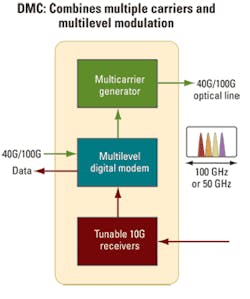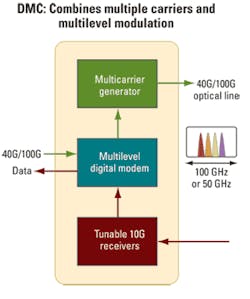by Meghan Fuller Hanna
OpVista (www.opvista.com) will debut its CX8 Optical Networking System, the successor to its OpVista2000, at NXTcomm08 this month in Las Vegas. Targeted at metro/regional networks up to 1,000 km in length, the CX-8 features a total system capacity of 8 Tbits/sec. But what makes it unique is the innovative way in which it supports 40G and 100G traffic, say OpVista representatives.
Unlike modulation schemes like duobinary, DQPSK, and DPSK, which require additional dispersion compensation mechanisms to mitigate the effects of chromatic and polarization-mode dispersion inherent in higher data rate transmission, OpVista says it has devised a technology that enables 40G transmission�with a near-term roadmap to 100G�over existing 10G networks without the need for any network re-engineering or the added cost of increased dispersion compensation. Dubbed Dense Multi-Carrier (DMC), the new technology is the cornerstone of the CX8 Optical Networking System and is designed to help OpVista compete with the likes of Nortel�s 40G/100G Adaptive Optical Engine.
Based on a combination of multiple carrier photonics, wavelength stabilization, and multilevel modulation, OpVista�s DMC technology packs multiple signal carriers�in this case, four�within an ITU window that normally holds just one. Thus, to the network infrastructure between CX-8 systems, the 40G of data looks like a single 10-Gbit/sec signal.
As a result, 40G transmission obeys 10G engineering rules. Operators will not need to change their dispersion compensation or worry about existing amplifiers, multiplexers, and ROADMs, OpVista asserts.
�If you were to go through a traditional network build using some of the conventional 40- and 100-Gbit technologies, you�d need to re-engineer the plants, touch everything from your dispersion compensation to your ROADMs to your amplification,� explains Zahir Addetia, vice president of product line management and strategy at OpVista. �In fact, what you are really doing is building a new fiber plant.�
Hand-in-hand with preserving the existing optical backbone is preserving�and maximizing�the operator�s capital investment in that network. Re-engineering the network for 40-Gbit/sec transmission and beyond is cost-prohibitive for many carriers. Addetia believes OpVista�s DMC technology is the most cost-effective on the market, establishing a true pay-as-you-grow paradigm. �If I had an existing fiber plant,� he says, �I can start populating my 40- and 100-gig transponders as needed. You simply add transponders to the network.�
OpVista says it also will offer a CX8-40G transponder as an upgrade for customers running other vendors� DWDM systems. OpVista recently completed a trial with UK-based provider Vtesse (www.vtesse.com) in which its transponder was used to inject a 40G signal over Vtesse�s existing (i.e., non-OpVista), mixed-fiber 10G network. The CX8-40G transponder is expected by the end of the year.
To reach 100G�which OpVista hopes to unveil in the first half of 2009�the company will tweak its 40G approach slightly. �What we have is five carriers carrying 20 Gbits of information, but it�s still 10-gig symbols per second,� Addetia explains, adding that some sort of advanced modulation format will be necessary. �That�s how we avoid PMD and chromatic dispersion issues; that�s the key to the optical performance.�
At NXTcomm08, OpVista will showcase the optical performance of its 100-Gbit/sec capabilities running over a 10-Gbit/sec network. �What we are planning to demonstrate is that you can have 10-gig signals carried together with some of the 100 gig using our technology,� he says. �This becomes very challenging as you go toward DQPSK, DPSK, and duobinary.�Dana Cooperson, vice president of network infrastructure at Ovum (www.ovum.com), believes there is a sizable market for technologies like DMC that leverage so much of the operator�s existing resources. �OpVista�s 40G DMC technology, which is based on mature 10G components and a novel combination of analog and digital design techniques, could expand the 40G market beyond our five-year forecast of 70% CAGR by lowering the 40G cost curve and increasing the range of addressable upgrade applications faster than we expected,� she reports.

